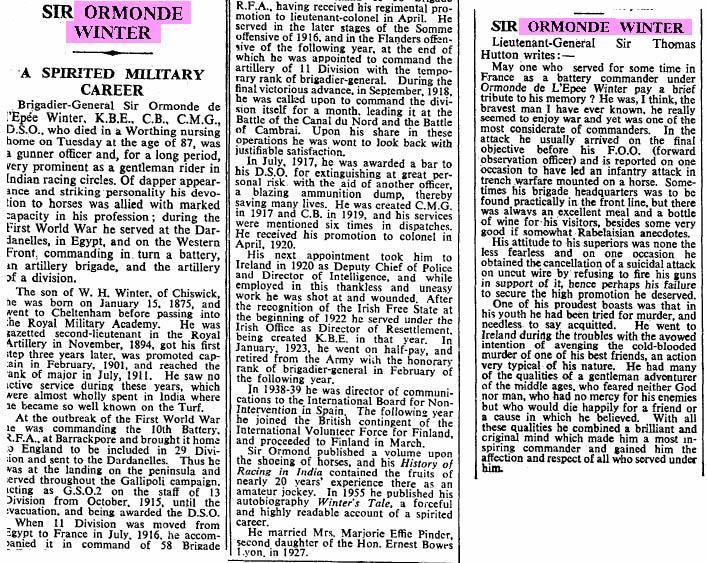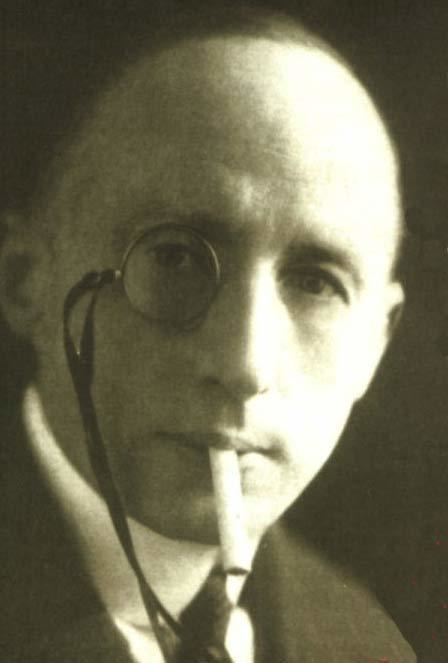Nickname(s) 'O' Died 1962 | Years of service -1924 Rank Brigadier general Name Ormonde Winter | |
 | ||
Awards Order of the British Empire, Order of the Bath, Order of St Michael and St George, Distinguished Service Order Battles and wars World War I, Irish War of Independence, Finland | ||
Brigadier-General Sir Ormonde de l'Épée Winter KBE CB CMG DSO (1875–1962) was a British Army officer and author who after service in World War I was responsible for intelligence operations in Ireland during the Anglo-Irish War. He later became a British Fascist and fought for the Finnish Army in the Winter War.
Contents

Service
Winter was a Royal Artillery officer and served in the First World War. He was appointed as Chief of the British Army intelligence branch and deputy chief of police in Dublin where he was known as "O," and "the holy terror". Prior to his appointment as CIO he was an 'old' Colonel, who next found himself a young Brigadier-General. Draconian in outlook he was reported to have precipitated the suicide of three of his juniors.
Irish War of Independence
He was appointed in May 1920 by the Secretary of State for War, Winston Churchill to replace his friend General Tudor as Chief of Intelligence. Even given Winter's lack of experience in the espionage field, 'O' impressed at the time with his initial reorganisation of heavily centralised departments. Mark Sturgis wrote of the Dublin Castle regime; "'O' is a marvel, he looks like a wicked little white snake, he can do anything". If nothing else he was innovative, yet his detractors claimed him to be obsessed with cloak and dagger operations.
In his final report to the British Government Winter listed the following as his main methods of intelligence gathering:
Many members of his exotically named "Cairo Gang" possibly named after their meeting place the Cairo Cafe or possibly due to many having served in the Middle East, met their end on Bloody Sunday in November 1920. The net result was that the intelligence service either retreated into Dublin Castle or evacuated to England. Another of his plans was for potential informers to write to a secret address in England, and the net result as he freely admitted was a pile of hoaxes and abusive mail. However, amidst this mass were some valuable nuggets of genuine intelligence. One informer for Winter, Vincent Fovargue was given safe haven in England, but with informers everywhere even inside Dublin castle (Michael Collins' female cousin was a stenographer who passed security checks but was later uncovered and arrested) Fovargue was tracked down and his body was found upon a golf course with the traditional message 'Spies and traitors beware.'
Another was revealed to be a criminal fraud, uncovered not by Winter but by newspaper reporters and IRA intelligence. The IRA allowed this man to live so that he could be uncovered. Other agents were more successful. One quoted at length in led a raid that captured 3 senior IRA members writing communiques to their subordinates. He rewrote the messages summoning all IRA leaders in the district to a meeting where they were arrested. Maintaining his cover as an IRA member he was placed into custody alongside them, gaining more intelligence from their conversation in jail.
Amongst Winter's other ideas was 'The Raid Bureau', a unit dedicated to analysing the vast amounts of paperwork generated by IRA leader Michael Collins. An obsessive clerk, his dedication to paperwork would to some degree compromise certain activities of the IRA, revealing arms supplies, financial records and even providing lists of IRA members and the identities of traitors within the police. Such documents were more valuable than any informer and could be presented in court as evidence which an informer would be unwilling to do. The principal reason for lack of informers, jury, and even judges in the civil courts was intimidation, which was one of the reasons martial law was in place.
Another innovation was collecting photographs of IRA members netted as results of raids. Winter was able to recruit at least three leading IRA members as informers and many lesser ranks. To supplement the crippled Cairo Gang, Winter formed the igoe Gang named after its commander, Eugene Igoe a policeman from County Galway, who was expelled from Ireland after the Anglo-Irish War. They were a unit of plain clothes police who had limited success in killing and capturing IRA members and a number of other young men who fell into their hands on the streets of Dublin. Ormonde personally killed one IRA assassin whilst shooting his way out of an ambush and captured another. Also, to counter IRA propaganda, Winter published his own versions of IRA newspapers, skilfully edited to subvert the Irish republican cause.
During the first months of 1921, Hamar Greenwood and others were declaring that the IRA was near defeat. However, it quickly became clear that the British Government strategy of combining repression with limited concessions was still not working. Faced with the choice of either waging a war of reconquest or negotiating peace, the government chose negotiation. A Truce was signed in July 1921, and the Treaty in December.
Later service
Winter retired from the army in 1924. In the 1920s Winter joined the directorship of the burgeoning but badly managed British Fascisti, which held several massive rallies (12,000 at one) in the London Parks, their followers being mainly women, ex suffragette types as The Times reported. Winter may have been an agent provocateur.
The director was Brigadier General Robert Byron Drury Blakeney ex Royal Engineers who was in part responsible for the birth of the extremist Imperial Fascist League. Through mismanagement and scandal the BF faded into obscurity in the late 1920s and membership was swallowed up by other fascist movements. In his book Winter makes virtually no mention of this period, perhaps under the Official Secrets Act. After the financial demise of the BF, he apparently took no further part in Fascist politics.
In 1940 at the age of 65, he offered his services to the Finnish Army, in their defence against Communist Russia. He was honoured for his service—certificates can be seen in his personal collection in the Imperial War Museum. He was a master of five Russo-Slavic languages and was a chain smoker. His obituary read that he neither feared God nor man, (Times Obits) and he boasted of having been cleared of manslaughter in his student youth, in an incident when a man was struck on a river with a rowing oar whilst attacking Winter.
